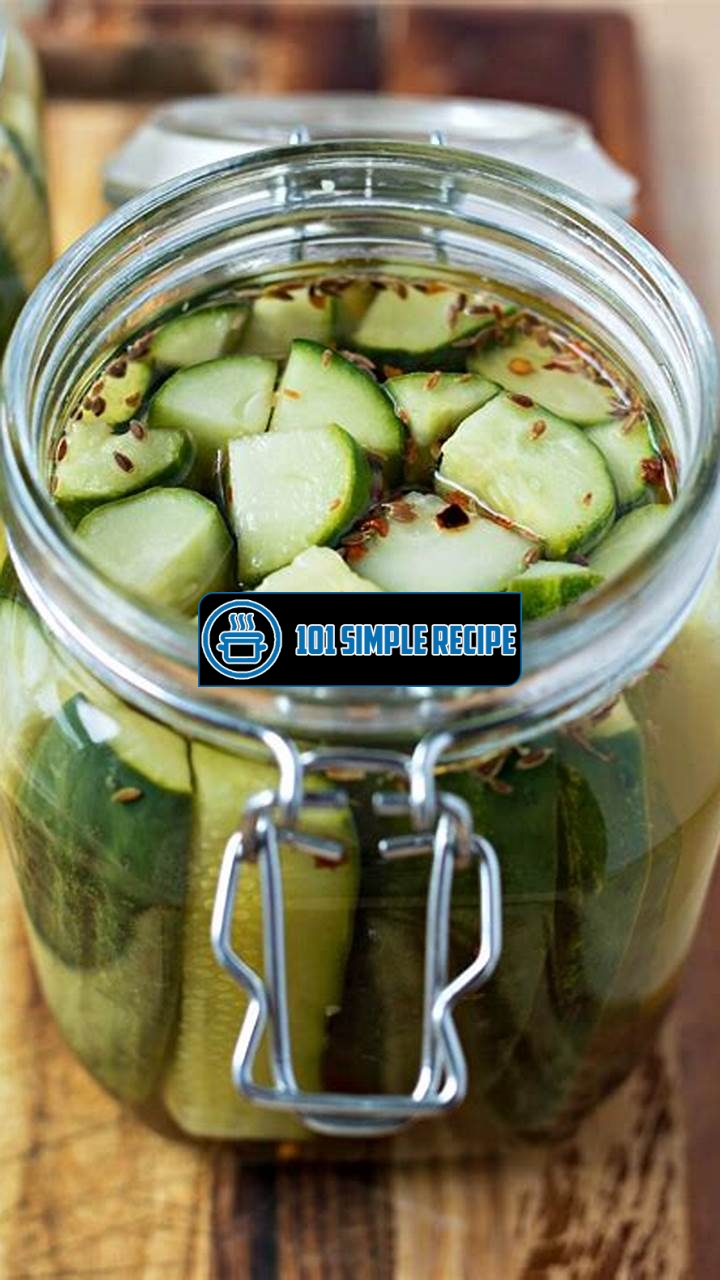Are you craving for some tangy and crispy pickles to amp up your meals? Look no further! In this article, we will guide you through easy steps to make delicious refrigerator pickles that will surely satisfy your taste buds. Whether you are a pickle aficionado or a beginner in the world of pickling, this recipe is perfect for you. So grab your apron, gather your ingredients, and get ready to make some mouthwatering pickles right in the comfort of your own kitchen. Let’s dive in!

Understanding the Basics of Refrigerator Pickles
Discovering the art of refrigerator pickles can turn your ordinary vegetables into delicious, tangy treats. If you’re a fan of pickled cucumbers, you’ll find this technique extremely useful. This section will help you understand the basics of refrigerator pickles and why they have become a popular choice for home pickling.
What are Refrigerator Pickles?
Refrigerator pickles are a type of pickled vegetables that are made using a cold brine solution and are stored in the refrigerator. Unlike traditional pickling methods that involve heat canning, refrigerator pickles are quick and easy to make. They are infused with flavors from herbs, spices, and other ingredients, resulting in a crisp and refreshing taste.
These pickles don’t require the use of vinegar or a boiling water bath. Instead, they rely on the acidity and salt content of the brine to preserve the vegetables and maintain their crisp texture. The pickles can be enjoyed within a day or two of making them and can last for several weeks in the refrigerator.
Advantages of Refrigerator Pickles
There are several advantages to making refrigerator pickles, making them an ideal choice for those who want a quick and convenient way to enjoy pickled vegetables.
-
1. Simple and Fast: The process of making refrigerator pickles is straightforward and doesn’t require any complex canning procedures. It can be done in a matter of minutes, making it perfect for busy individuals or those new to home pickling.
2. Crisp Texture: The cold brine used in refrigerator pickles helps maintain the crispness of the vegetables. This results in a satisfying crunch when you bite into them.
3. Versatility: Refrigerator pickles can be made with a wide variety of vegetables, such as cucumbers, carrots, radishes, and cauliflower. You can experiment with different flavors and combinations to match your personal taste.
4. No Special Equipment Needed: Unlike traditional pickling methods, refrigerator pickles don’t require specialized canning equipment. You can easily make them using basic kitchen tools and store them in ordinary glass jars or containers. ️
Tips for Choosing the Right Ingredients
Choosing the right ingredients is key to making delicious refrigerator pickles. Here are some tips to help you select the best ingredients for your pickling adventure.
-
1. Fresh Vegetables: Ensure that you use fresh and high-quality vegetables for the best results. Vegetables that are slightly underripe work well as they tend to retain their crisp texture.
2. Organic or Homegrown: If possible, opt for organic vegetables or those grown in your own garden. They are free from pesticides and other chemicals, which can affect the taste and quality of the pickles.
3. Seasonal Varieties: Pick vegetables that are in season to ensure maximum flavor and freshness. Seasonal produce tends to be more readily available and economical as well.
4. Quality Brine Ingredients: Use high-quality vinegar, salt, and spices to make the brine. This will enhance the overall flavor of the pickles and ensure a satisfying taste.
By understanding the basics of refrigerator pickles and following these tips, you’ll be well on your way to creating your own delicious, homemade pickled vegetables. Get ready to enjoy the tangy goodness of refrigerator pickles with every bite! ️
Gathering the Essential Equipment
When it comes to making delicious refrigerator pickles, having the right tools and containers is essential. These items will help you create pickles effortlessly and ensure they turn out perfectly every time.
Choosing the Right Pickling Containers
When selecting containers for your refrigerator pickles, there are a few key factors to consider. First and foremost, you’ll want to choose containers that are made of glass. This is because glass containers are non-reactive and won’t interact with the acidic brine that pickles are soaked in. Additionally, glass containers are easy to clean and sanitize, which is important for preserving the freshness and flavor of your pickles.
Another important feature to look for in pickling containers is airtight lids. Airtight containers help to seal in the flavors and prevent any unwanted odors from seeping into your pickles. This is especially important if you plan to store your pickles in the refrigerator for an extended period of time.
Lastly, consider the size and shape of the containers. Look for containers that are tall and narrow, as this allows the pickles to be fully submerged in the brine. This ensures that all of the cucumbers are evenly infused with the flavors of the brine.
Essential Tools for Making Refrigerator Pickles
In addition to pickling containers, there are a few tools that will make the process of making refrigerator pickles even easier. One essential tool is a sharp knife. A sharp knife allows you to easily slice the cucumbers into uniform rounds or spears, which not only looks visually appealing but also ensures that the cucumbers pickle evenly.
Another tool that can come in handy is a mandoline slicer. This tool allows you to quickly and easily slice the cucumbers into thin, uniform slices. This is especially useful if you prefer a more delicate pickle texture. However, be sure to exercise caution when using a mandoline slicer, as the blades are extremely sharp.
A wide-mouth funnel is another helpful tool to have on hand. It makes transferring the cucumbers from the cutting board to the pickling containers a breeze, and also helps to prevent any spills or messes.
Understanding the Importance of Proper Sanitation
When it comes to making refrigerator pickles, proper sanitation is absolutely crucial. Failing to properly clean and sanitize your equipment can result in the growth of harmful bacteria, which can spoil your pickles and make them unsafe to consume.
Before you begin the pickling process, make sure to thoroughly clean and sanitize your pickling containers, knives, and any other tools that will come into contact with the cucumbers or brine. This can be done by washing them in hot, soapy water and then rinsing them well. Alternatively, you can run them through the dishwasher on a high-temperature setting to ensure they are properly sanitized.
Additionally, be sure to wash the cucumbers thoroughly before slicing them. This removes any dirt or bacteria that may be present on the skin. Finally, remember to wash your hands thoroughly with soap and water before handling any of the ingredients or equipment.
By gathering the essential equipment, choosing the right pickling containers, having the necessary tools, and understanding the importance of proper sanitation, you’ll be well on your way to making delicious refrigerator pickles that will impress your family and friends. Enjoy your homemade pickles with sandwiches, burgers, or as a tangy addition to your favorite salads!
Mastering the Art of Flavorful Brine
When it comes to making delicious refrigerator pickles, mastering the art of flavorful brine is essential. The brine is what gives pickles their distinct taste and crisp texture. In this section, we will explore the key components of a flavorful brine and how you can create your own signature blend.
The Role of Vinegar in the Brine
Vinegar plays a crucial role in the brine as it provides the tangy and acidic flavor that is characteristic of pickles. There are several types of vinegar to choose from, including white vinegar, apple cider vinegar, and white wine vinegar. Each type of vinegar imparts a slightly different taste to the pickles, so feel free to experiment and find your favorite.
- White vinegar: Known for its clean and sharp taste, white vinegar is a popular choice for pickling. It pairs well with a variety of herbs and spices, allowing you to create a versatile brine.
- Apple cider vinegar: If you prefer a slightly sweeter flavor, apple cider vinegar is a great option. It adds a subtle fruity note to the pickles and works well with ingredients like dill and garlic.
- White wine vinegar: For a more sophisticated flavor profile, white wine vinegar is an excellent choice. It lends a delicate and nuanced taste to the pickles, making it perfect for pairing with delicate herbs like tarragon or thyme.
Tip: Feel free to mix different types of vinegar to create a unique and complex flavor profile for your pickles.
Choosing the Right Salt for Brining
When it comes to brining, not all salts are created equal. The type of salt you use can significantly impact the taste and texture of your pickles.
- Kosher salt: Kosher salt is a popular choice for brining as it dissolves easily and does not contain any additives. Its coarse texture helps draw out the moisture from the cucumbers, resulting in crispy pickles.
- Sea salt: Sea salt is another option that can add a subtle briny flavor to your pickles. It is important to note that sea salt can vary in texture, so make sure to choose a fine or medium variety for brining.
- Pickling salt: Specifically made for pickling, pickling salt is finely ground with no additives. It dissolves quickly, ensuring that the flavors are evenly distributed throughout the brine.
Tip: Avoid using table salt for pickling as it often contains anti-caking agents that can affect the clarity and taste of your brine.
Enhancing Flavors with Herbs and Spices
To take your pickles to the next level, consider adding herbs and spices to the brine. These extra ingredients can enhance the flavor profile and add a unique twist to your homemade pickles.
Here are some popular herbs and spices that pair well with pickles:
- Dill: Dill is a classic herb that complements the tanginess of the vinegar. It adds a fresh and aromatic flavor to the pickles.
- Garlic: Garlic brings a savory and robust taste to pickles. It pairs well with almost any herb or spice and adds depth to the overall flavor.
- Peppercorns: Peppercorns add a subtle heat and earthy flavor to the pickles. You can use black, white, or mixed peppercorns, depending on your preference.
- Mustard seeds: Mustard seeds provide a mild and slightly tangy taste that pairs well with the acidity of the vinegar. They also add a pleasing texture to the pickles.
Tip: Don’t be afraid to get creative with your herb and spice combinations. Feel free to experiment with ingredients like bay leaves, coriander seeds, or even chili flakes to create your own unique pickle recipe.
By mastering the art of flavorful brine, you can create delicious refrigerator pickles that are bursting with flavor. Remember to choose the right vinegar, salt, and herbs/spices to customize your pickles according to your taste preferences. With a little experimentation, you’ll be able to create your own signature blend that will impress friends and family alike.
If you’re looking for a weight-loss recipe, try this Weight Loss Recipe. It’s a healthy and flavorful option for your diet.
Selecting the Perfect Pickling Ingredients
When it comes to creating delicious refrigerator pickles, selecting the right ingredients is key to achieving that perfect balance of flavors. In this section, we will explore the best vegetables, fruits, and additional flavorings that you can use to create your own unique pickling combinations.
Best Vegetables for Pickling
If you are a fan of tangy and crisp pickles, then certain vegetables work exceptionally well. Cucumbers, of course, are the classic choice. They are crisp and refreshing, offering the perfect base for pickling flavors. Other popular vegetables for pickling include carrots, radishes, onions, and green beans. These vegetables not only absorb the pickling brine well but also provide a delightful crunch in every bite.
Pro tip: Experiment with different varieties of cucumbers, such as pickling cucumbers or English cucumbers, to find your favorite texture and flavor.
Adding a Touch of Fruit to Your Pickles
If you want to add a subtle sweetness to your refrigerator pickles, consider incorporating fruits into the mix. Fruits like apples, pears, and berries can provide a pleasant contrast to the tangy brine. They add a touch of natural sweetness and depth of flavor to your pickles. Just make sure to select fruits that will hold up well during the pickling process, maintaining their texture and taste.
Pro tip: Try slicing apples or pears thinly and layering them between the vegetables in your pickling jar for a burst of fruity goodness in every bite.
Exploring Unique Flavor Combinations
Now that you have selected your vegetables and, perhaps, added a touch of fruit, it’s time to get creative with unique flavor combinations. Feel free to experiment with different herbs and spices, such as dill, garlic, mustard seeds, or red pepper flakes. These additional flavorings can transform your refrigerator pickles and take them to the next level.
Pro tip: Don’t shy away from exploring unconventional flavor combinations. For example, try adding fresh herbs like rosemary or basil for an aromatic twist, or even experiment with adding a hint of ginger for a pleasantly spicy kick.
By carefully selecting your pickling ingredients and considering unique flavor combinations, you can create mouthwatering refrigerator pickles that will leave your taste buds craving for more. So, gather your favorite vegetables, fruits, and flavorings, and embark on a pickling adventure that will elevate your culinary creations.
To make easy refrigerator pickles, you can follow this White Castle recipe. It’s a simple and delicious recipe that you can try.
The Pickling Process Made Simple
Welcome to the world of homemade refrigerator pickles! There’s nothing quite like the tangy, crispy goodness of a pickle that you’ve made yourself. With just a few simple steps, you can have a jar full of deliciousness ready to enjoy in no time. Let’s dive right in!
Preparation and Cutting Techniques
Before you begin pickling, it’s important to properly prepare your ingredients. Start by gathering fresh cucumbers, preferably small to medium in size. Rinse them thoroughly under cool water to remove any dirt or debris. Next, you’ll want to trim off the ends of the cucumbers. This will help ensure that your pickles have a consistent texture.
Now it’s time to decide how you want to cut your cucumbers. There are a few popular options to choose from:
- Whole pickles: If you prefer a classic pickle shape, simply leave your cucumbers whole.
- Slices: For a sandwich-ready pickle, slice your cucumbers into thin rounds.
- Spears: If you like a pickle with a bit more crunch, cut your cucumbers into thick spears.
Once you’ve settled on a cutting technique, place your sliced or whole cucumbers into a large bowl. Now it’s time to move on to the brining process.
Brining and Soaking Times
To give your pickles that classic zing, you’ll need to brine them in a mixture of vinegar, water, salt, and sugar. The exact measurements will vary depending on personal preference, but a general guideline to follow is a ratio of 1 cup vinegar to 1 cup water, with 1 tablespoon each of salt and sugar.
Pour the brine mixture over your cucumbers, making sure they are fully submerged. Let them soak for at least 24 hours in the refrigerator. This will allow the flavors to meld together and the pickles to develop their distinctive taste. If you prefer a stronger flavor, you can let them soak for up to 48 hours.
Storing and Enjoying Your Refrigerator Pickles
Once your pickles have finished soaking, it’s time to transfer them to jars for storage. Mason jars work well for this purpose. Pack the cucumbers tightly into the jars, leaving a small amount of headspace at the top.
Now comes the best part – enjoying your homemade refrigerator pickles! These tasty treats can be enjoyed right away, but the flavors will continue to develop over time. Give them at least a week to sit in the refrigerator before digging in. This allows the flavors to fully infuse into the pickles and creates the perfect balance of tanginess and crunchiness.
Now that you have the know-how, go forth and pickle! Experiment with different spices and flavorings to create your own signature pickle recipe. You’ll soon discover that making your own refrigerator pickles is not only easy but also incredibly rewarding. Enjoy!
For a refreshing beverage to accompany your pickles, you can make this Punch Bowl recipe. It’s a great choice for parties and gatherings.
Thank you for taking the time to read our article on how to make easy refrigerator pickles. We hope you found the instructions and tips helpful in creating your own delicious homemade pickles. Don’t hesitate to visit us again later for more mouthwatering recipes and helpful kitchen tips. Happy pickling!
Frequently Asked Questions
Here are some commonly asked questions about making easy refrigerator pickles:
| No. | Questions | Answers |
|---|---|---|
| 1 | Can I use any type of cucumber to make refrigerator pickles? | Yes, you can use any type of cucumber, but smaller varieties like Kirby or Persian cucumbers work best for refrigerator pickles. |
| 2 | How long do refrigerator pickles last? | Refrigerator pickles can last up to one month when stored properly in a sealed container in the refrigerator. |
| 3 | What spices can I add to my refrigerator pickles? | You can add spices like dill, garlic, peppercorns, or red pepper flakes to customize the flavor of your refrigerator pickles. |
| 4 | Do I need to sterilize the jars before making refrigerator pickles? | Since refrigerator pickles are not preserved in a canning process, sterilizing the jars is not necessary. However, make sure the jars are clean before use. |
| 5 | Can I adjust the amount of sugar in the pickling brine? | Yes, you can adjust the amount of sugar to your taste preferences. The sugar helps balance the flavors and adds sweetness to the pickles. |
| 6 | Can I reuse the pickling brine for another batch of pickles? | Yes, you can reuse the pickling brine for another batch of pickles, but the flavor may be weaker in subsequent batches. |
Enjoy Your Homemade Refrigerator Pickles
Now that you know how to make easy refrigerator pickles, it’s time to put your newfound knowledge to use. Gather your ingredients, follow the step-by-step instructions, and enjoy the tangy, crisp taste of homemade pickles. Remember, the best part about refrigerator pickles is that you can enjoy them in just a few hours. So, why not start pickling today? Dig in and satisfy your pickle cravings with your very own homemade batch. Happy pickling!
Jump to Recipe
Easy Refrigerator Pickles

Learn how to make easy refrigerator pickles with this simple recipe. Tangy, crisp, and full of flavor, these homemade pickles are the perfect addition to any meal or snack.
- Cucumbers
- White vinegar
- Water
- Salt
- Granulated sugar
- Dill seeds
- Garlic cloves
- Wash and slice the cucumbers into thin rounds or spears. Remove any ends that are not fresh.
- In a saucepan, combine white vinegar, water, salt, and sugar. Heat over medium heat until the sugar and salt dissolve completely.
- Place the cucumber slices or spears in sterilized jars. Add dill seeds and garlic cloves for added flavor.
- Carefully pour the hot pickling brine over the cucumbers, leaving a 1/2-inch headspace at the top of each jar.
- Seal the jars with lids and refrigerate for at least 2 hours before enjoying. The longer the pickles are refrigerated, the more flavorful they become.
- Once the pickles have chilled, they are ready to be enjoyed. Serve them as a side dish, snack, or add them to sandwiches and salads for extra crunch and flavor.






